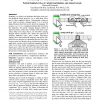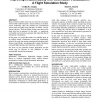CHI
2005
ACM
14 years 12 months ago
2005
ACM
We present the design and evaluation of the vacuum, a new interaction technique that enables quick access to items on areas of a large display that are difficult for a user to rea...
CHI
2005
ACM
14 years 12 months ago
2005
ACM
The potential for sensor-enabled mobile devices to proactively present information when and where users need it ranks among the greatest promises of ubiquitous computing. Unfortun...
CHI
2005
ACM
14 years 12 months ago
2005
ACM
Snapping is a widely used technique that helps users position graphical objects precisely, e.g., to align them with a grid or other graphical objects. Unfortunately, whenever user...
CHI
2005
ACM
14 years 12 months ago
2005
ACM
We study a collaborative location-based game in which groups of `lions' hunt together on a virtual savannah that is overlaid on an open playing field. The game implements a s...
CHI
2005
ACM
14 years 12 months ago
2005
ACM
Although gender differences in a technological world are receiving significant research attention, much of the research and practice has aimed at how society and education can imp...
CHI
2005
ACM
14 years 12 months ago
2005
ACM
This paper presents an exploration of user interfaces, persuasive interfaces and feedback techniques in the domain of the sink. Waterbot is a system to inform and motivate behavio...
CHI
2005
ACM
14 years 12 months ago
2005
ACM
Many aircraft accidents each year are caused by encounters with invisible airflow hazards. Recent advances in aviation sensor technology offer the potential for aircraft-based sen...
CHI
2005
ACM
14 years 12 months ago
2005
ACM
Pervasive personal communication technologies offer the potential for important social benefits for individual users, but also the potential for significant social difficulties an...
CHI
2005
ACM
14 years 12 months ago
2005
ACM
A virtually connected medium called tranStick is described that functions both as a "virtual wire" and as a "memory card" containing a shared space. A user can...


